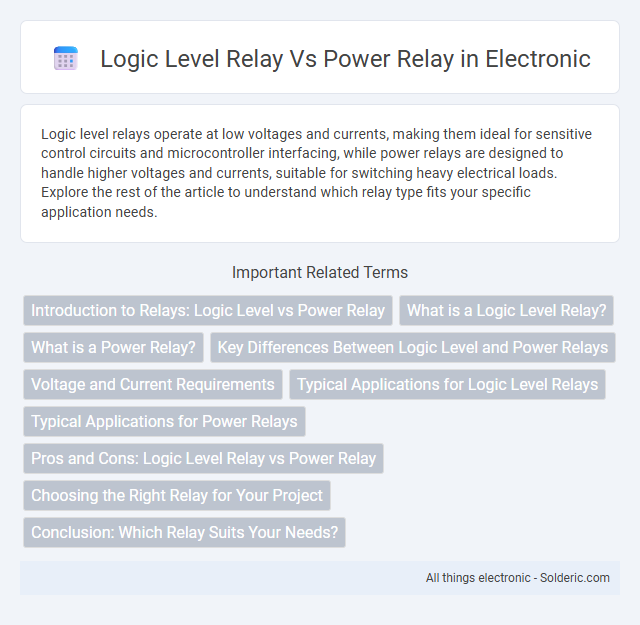Logic level relays operate at low voltages and currents, making them ideal for sensitive control circuits and microcontroller interfacing, while power relays are designed to handle higher voltages and currents, suitable for switching heavy electrical loads. Explore the rest of the article to understand which relay type fits your specific application needs.
Comparison Table
| Feature | Logic Level Relay | Power Relay |
|---|---|---|
| Control Voltage | Low voltage (3-24V DC) | High voltage (110-240V AC/DC) |
| Contact Rating | Low current (up to 2A) | High current (up to 30A or more) |
| Application | Microcontroller interfacing, signal switching | Motor control, heavy load switching |
| Size | Compact and small | Larger and bulky |
| Response Time | Fast switching | Slower switching |
| Isolation | Opto-isolated versions common | Electromagnetic isolation typical |
| Durability | Lower mechanical endurance | Higher mechanical endurance |
| Cost | Lower cost | Higher cost |
Introduction to Relays: Logic Level vs Power Relay
Logic level relays operate with low voltage control signals, making them ideal for sensitive electronic circuits and microcontroller interfaces. Power relays handle higher voltage and current loads, suitable for switching heavy electrical devices and industrial equipment. Your choice depends on the application's voltage requirements and load capacity, ensuring efficient and safe operation.
What is a Logic Level Relay?
A Logic Level Relay operates at low voltage signals, typically compatible with microcontrollers and digital circuits, enabling direct switching without additional driver components. It features low coil voltage requirements, usually around 3-5V DC, making it ideal for logic-level control interfaces in embedded systems. Unlike power relays designed for high voltage and current loads, logic level relays optimize integration with sensitive, low-power electronics for signal-level switching applications.
What is a Power Relay?
A power relay is an electromechanical switch designed to control high voltage and high current circuits with a low voltage control signal, commonly used in industrial applications and heavy machinery. These relays can handle large loads such as motors, lighting systems, and heating elements, providing electrical isolation and protection. Power relays typically feature robust construction, higher contact ratings, and improved durability compared to logic level relays.
Key Differences Between Logic Level and Power Relays
Logic level relays operate at low voltage and current levels, typically controlled by microcontrollers or digital circuits for signal switching. Power relays are designed to handle higher voltages and currents, suitable for switching heavy loads like motors or industrial equipment. The main differences lie in their voltage rating, current capacity, switching mechanism, and intended application, with logic level relays prioritizing low power control and power relays emphasizing high power handling.
Voltage and Current Requirements
Logic level relays operate at low voltage levels, typically 3V to 32V DC, and are designed to switch low current loads up to around 2A, making them ideal for interfacing directly with microcontrollers and logic circuits. Power relays, in contrast, handle much higher voltages and currents, often switching AC voltages up to 250V or more and currents ranging from 10A to 30A or greater for industrial and heavy-duty applications. Choosing between these relays depends on the control signal voltage available and the load's current and voltage demands to ensure proper operation and safety.
Typical Applications for Logic Level Relays
Logic level relays are commonly used in low-voltage control circuits and microcontroller interfaces where precise signal switching is essential, such as in automation systems, robotics, and communication devices. Their ability to operate directly from logic-level signals makes them ideal for integrating with digital electronics and minimizing power consumption. Your projects benefit from their compact size and fast response times when controlling low-power devices or triggering other relay types.
Typical Applications for Power Relays
Power relays are commonly used in high-current applications such as motor control, HVAC systems, and industrial machinery, where switching higher voltages and currents is essential. These relays handle loads that exceed the capacity of logic level relays, making them ideal for controlling devices like compressors, pumps, and lighting systems. Their robust design ensures reliable operation in demanding environments requiring frequent switching and durability.
Pros and Cons: Logic Level Relay vs Power Relay
Logic Level Relays offer low-voltage control advantages, consuming minimal power and enabling precise circuit switching in sensitive electronics, but they typically handle lower current loads compared to Power Relays. Power Relays excel in managing high current and voltage applications, providing robust durability and higher load capacity, though they require more power to operate and may generate more heat. Your choice depends on balancing control precision and load requirements, ensuring optimal performance for your specific application.
Choosing the Right Relay for Your Project
Choosing the right relay for your project depends on the control signal voltage and the load requirements. Logic level relays operate directly at low voltage signals (3.3V or 5V) ideal for microcontroller interfaces, ensuring efficient switching of low-power loads. Power relays handle higher currents and voltages, suitable for driving motors, heaters, or industrial equipment, so your choice must align with the electrical specifications and operational demands of your application.
Conclusion: Which Relay Suits Your Needs?
Logic level relays are ideal for low voltage control circuits requiring minimal current, offering fast switching and compatibility with microcontrollers and digital logic signals. Power relays handle higher currents and voltages, making them suitable for heavy-duty applications such as motor control and industrial machinery. Selecting the right relay depends on your specific application voltage, current requirements, and control system compatibility to ensure optimal performance and reliability.
Logic Level Relay vs Power Relay Infographic

 solderic.com
solderic.com